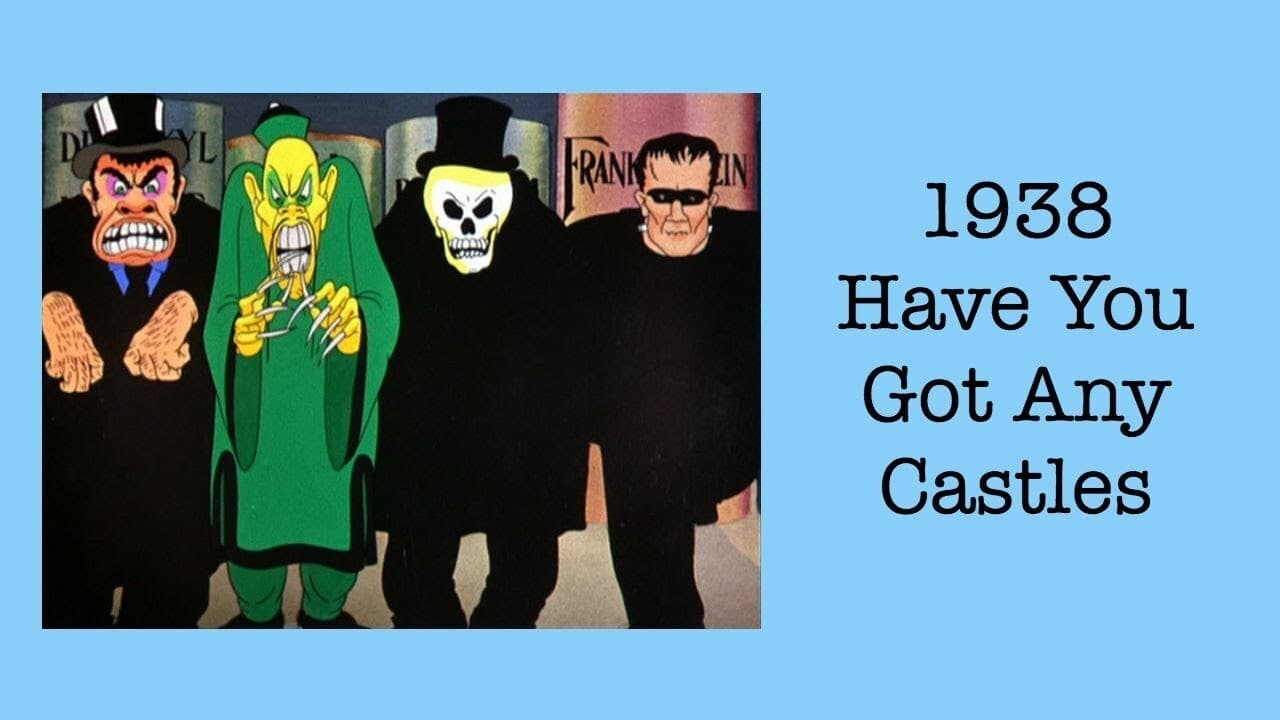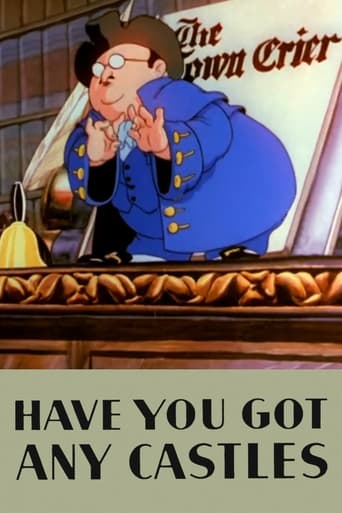Claysaba
Excellent, Without a doubt!!
Kaydan Christian
A terrific literary drama and character piece that shows how the process of creating art can be seen differently by those doing it and those looking at it from the outside.
Mehdi Hoffman
There's a more than satisfactory amount of boom-boom in the movie's trim running time.
Philippa
All of these films share one commonality, that being a kind of emotional center that humanizes a cast of monsters.
MartinHafer
Before this short begins, there is a little written prologue about the racist nature of some of the humor in the film--as a sort of warning. I appreciate this instead of just censoring or hiding the film, as it IS a part of our history (for good or bad).The color in this film is quite nice--vivid and better than the average 30s cartoon. What follows are a long series of mostly lame jokes where books come to life--with characters coming off the pages. The Asian and Black characters are a bit overdone (especially with the large-lipped Black cartoon characters), though compared to a lot of the images of Blacks in films of the time, this is relatively benign. I am not excusing it--but it could have been and often was a lot worse! Unfortunately, despite a clever idea and nice animation, I must also admit that most of the jokes weren't that funny and there was too much singing. On the plus side, however, there were lots of references to famous Hollywood films and actors, so lovers of classic Hollywood will probably enjoy this more than the average viewer. Not great but compared to the average cartoon of the 1930s, this is actually a bit better than average. Cartoons of the 40s would evolve for the better--with far less singing, better laughs and an edge--all which are problems with "Have You Got Any Castles?".
Mathieu Lefebvre
If cartoon characters can interact with each other in "Who Framed Roger Rabbit", why not literary characters? Instead of producing another wacky cartoon about Bugs Bunny, Tweety or another silly character, Merry Melodies did a wise move in crafting a musical/short story about book characters.Opening with a dance number with Mr. Hyde, Fu Man Chu, the Phantom of the Opera and Frankenstein, it next moves to Green Pastures, Old King Cole, Louis Pasteur, Mutiny on the Bounty, Heidi etc. etc.But the interaction is also interesting. For example, Thin Man becomes fat after visiting a cook book, Rip Van Winkle tries to prevent himself from hearing Old King Cole...After that, a plot develops: the Three Musketeers steal the 7 keys to Baldpate in order to free the Prisoner of Zenda. They are instantly chased and they have to flee from the cannons of the Light Brigade, Robinson Crusoe and All Quiet on the Western Front. Ultimately, Rip Van Winkle blows everybody with a Hurricane and it's all Gone With the Wind...I can't stop myself from watching it, because it's simply a highly imaginative and entertaining musical story and it's funnier than some Disney and Looney Tunes cartoons. I (disappointingly) think that it's the kind of story that we won't find in today's children's videos and for a long time, if it's not for ever. It's desolating, because it's some great stuff.
Robert Reynolds
There's a great deal to say about this short and some detail is necessary, so spoilers are ahead.This short is an excellent example of a type of cartoon that Warner Brothers did very effectively: Characters from books and/or magazines coming to life or being used as part of a sight gag. Generally set in a bookstore, the first done was Three's a Crowd, done in 1933.Castles originally featured a caricature of Alexander Wollcott doing an opening and a close as the "Town Crier", but the studio heads were afraid Wollcott might take offense and the framing sequences were removed. Caricatures were a staple of animation by this point and Castles features a number of them.Why did the animators do these type of cartoons? I suspect it was because it gave them the advantage of using material that would be very familiar to the audience on at least two levels: books that were familiar to a fairly well-read public (or magazine titles familiar to that same public) as well as a visual connection, given that many of these books had also been made into films. Given that animation is a very visual medium by it's nature, audience familiarity with titles and faces allowed the animators to fire dozens of short sight gags at the audience in a short time-frame. Audience recognition of W.C Fields or Greta Garbo, coupled with wide familiarity with books like So Red the Rose and So Big makes the gags work in different ways for different viewers. They did these for the same reason books were adapted into films: audience familiarity with the subject matter. Studios routinely optioned film rights to best-selling books on the not unsound theory that someone who read the book and liked it would pay to see a film version as well. Back in the 1930s, the four principle forms of entertainment were radio, movies, reading and music. Cartoons strip-mined all four for material and Warner's did this superbly. They even re-used themselves on occasion, including a bit in Castles that was first used in Clean Pastures and is used here ("Swing For Sale").This short is in print on Looney Tunes Golden Collection, Vol. 2, with the original Wollcott framing sequences included. Highly recommended.
Varlaam
As entertainment, this cartoon is really just a sequence of throwaway gags. Characters from literature and popular fiction participate in a series of mostly bad visual puns. That's the premise. The cartoon's interest actually lies elsewhere.While we're ostensibly seeing a parody of great books, nearly every book referred to had been a film a few years prior to the release of the cartoon.A few of the references unmistakably caricature the star of the earlier film: William Powell in "The Thin Man" series, Paul Muni in "The Story of Louis Pasteur", Charles Laughton as Captain Bligh, Edward Arnold as "Diamond Jim" Brady, Victor McLaglen as "The Informer".Some of the gags have no real connection to the book and film: Heidi sings like Cab Calloway (hey, "Hi-De-Ho"). (And a movie audience of smirking hepcats would rather hear zoot-suited Cab than precocious Shirley Temple, anyway.) The reference to Ferber's "So Big" makes fun of a vain actress. (I'm not positive about that caricature. Katharine Hepburn perhaps? She had been box office poison for some time.) "So Red the Rose" is retitled "Nose" for a "poke" at W.C. Fields. That's not irreverent; that's an obvious buttress for his profitable screen persona.It's plain to see that books as such are secondary. The jokes in effect are affirming a smug moviegoer's inexperience with actual literature by only showing what had been processed, and pasteurized, at the Hollywood film factory.So we are really given a glimpse at what had succeeded in making an impression on the popular culture by 1938. As far as I can see, the films honoured by inclusion are all recent products of the studio system, with only a few exceptions.One clearly British film is alluded to, "The 39 Steps" (1935). Does that imply that Hitchcock was making a real impact on the American mass market? Certainly Hitch came over to the States not long after 1938 (and he had made "Sabotage" in 1936 with an imported U.S. cast).There is also what I take as a direct reference to the banquet scene from Alexander Korda's "The Private Life of Henry VIII" (1933). Henry Tudor may have been corpulent but he was noted more for his wives than for his feasting, which is why I think the brief reference to Henry evokes this film. Was Korda's film well known in its own right? Or was it simply due to the presence of Laughton, the only person seemingly parodied twice in this cartoon, once allusively in this British film, and once explicitly in "Mutiny on the Bounty", an American film?Only one silent film unequivocally finds a place here. That's the Lon Chaney "Phantom of the Opera" from 1925, specifically its Masque of the Red Death episode with the Chaney character wearing his striking skull mask. Does that represent the fullest extent of the memories of 1938 picture show patrons?There are a couple of books whose cinematic incarnations are not all that impressive on their own, and which cannot reasonably account for the books' inclusion here in pastiche form. Therefore one can conclude that "Robinson Crusoe" and "Uncle Tom's Cabin" were books that people were aware of as books. But the list really is that short. Hawthorne's "House of the Seven Gables" is here too. It had not been a film within recent memory. One suspects strongly that the pun potential was too great to let that one get away, not that Hawthorne was cresting a wave of popular adulation at the time.Otherwise, practically the only book mentioned which had *never* been made into a movie was "Gone With The Wind". Hmm, is there any chance that that book became a popular film AFTER 1938?In fact, was the Margaret Mitchell book slated for production already by that year? Surely the rights had been sold by then. The book was published in 1936 and was a phenomenon from the outset, a veritable Wirtschaftswunder, a happenstance hapax legomenon. Yeah, it was a popular read alright. So including it here with the other books would represent a foregone conclusion; there would definitely have to be a film sooner or later, and probably sooner.John Ford's "Drums Along the Mohawk" (1939) may also fall into this category of publishing successes coming soon to a theatre near you. Cartoonists read the industry scuttlebutt in Variety too.(Try this on for size: "Ub drubs pubs' flubs". (Hey, you think it's easy thinking up bogus Variety headlines? Just try it!) Interpret that as, "Animator lampoons foolish books".)In conclusion then, I would characterize this unusual cartoon as a notable historical curiosity which should happen to have broad appeal for film buffs. It allows us to exercise our arcane movie knowledge. (Or should that be exorcise?)

